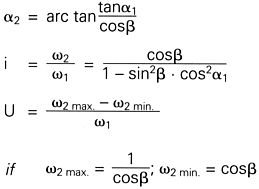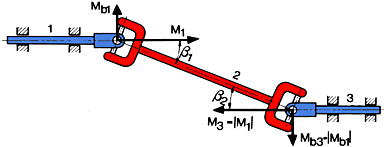![]()
![]()
![]() DANA
Commercial Drive Shafts Catalogue
DANA
Commercial Drive Shafts Catalogue
| Drive Shafts | |
|
|
| Installation and Maintenance | ||
| tt back to Table of contents | ||
| Load
on connection bearings The bearings of the driving and the driven shafts are strained by statle and dynamic forces and moments. These bearing forces result from: Static bad due to Dynamic bad due to Bearing forces due to torque deviation The torque equation for a deflected joint is:  (See "General fundamental theory ") If the transmitted power (N) is taken as constant (no friction losses), the torque relation can also be es follows:   The extremes of the transmission i are:  Thus also:  Bearing forces due to Iengh alteration 
 With a constant drive capacity resp. with a constant drive torque Thus the driven torque 
 
 The universal shaft with two joints in the Z-arrangement shown is Ioaded with the following moments. Here, as for the single joint, only the two extreme positions are shown.     In general: Radial forces on connecting bearings For universal shafts with two joints mounted normally while observing the installation instructions it is usually enough to know the greatest reaction forces in the bearings of the driving and driven shafts, which occur two times per rotation. The following calculation scheme may be helpful. (See "Calculation scheme") Axial forces on connecting bearings Axial forces on connecting bearings are encountered in the form of reaction forces due to: These axial forces are a function of: |
||
| tt back to Table of contents | ||
| Email : info@landmark-autoparts.com | Websites |
|